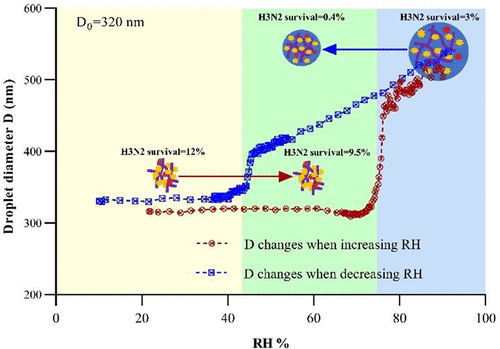当前位置:
X-MOL 学术
›
Environ. Sci. Technol. Lett.
›
论文详情
Our official English website, www.x-mol.net, welcomes your feedback! (Note: you will need to create a separate account there.)
Humidity-Dependent Survival of an Airborne Influenza A Virus: Practical Implications for Controlling Airborne Viruses
Environmental Science & Technology Letters ( IF 10.9 ) Pub Date : 2021-04-20 , DOI: 10.1021/acs.estlett.1c00253 Sadegh Niazi 1 , Kirsty R. Short 2 , Robert Groth 1 , Luke Cravigan 1 , Kirsten Spann 3 , Zoran Ristovski 1 , Graham R. Johnson 1
Environmental Science & Technology Letters ( IF 10.9 ) Pub Date : 2021-04-20 , DOI: 10.1021/acs.estlett.1c00253 Sadegh Niazi 1 , Kirsty R. Short 2 , Robert Groth 1 , Luke Cravigan 1 , Kirsten Spann 3 , Zoran Ristovski 1 , Graham R. Johnson 1
Affiliation

|
Relative humidity (RH) can affect influenza A virus (IAV) survival. However, the mechanism driving this relationship is unknown. We hypothesized that the RH-dependent survival of airborne IAV could be predicted by the efflorescence/deliquescence divergent infectivity (EDDI) hypothesis. We determined three distinct RH response zones based on the hygroscopic growth factor of carrier aerosols. These zones were classified as the super-deliquescence zone (RH > 75%), the hysteresis zone (43% < RH < 75%), and the sub-efflorescence zone (RH < 43%). We added IAV (H3N2) to protein-enriched saline and aerosolized it into sub-efflorescence or super-deliquescence zone air, yielding aerosols in the effloresced or noneffloresced state, respectively. We then adjusted the RH to an ergonomically comfortable RH (60%). Fifteen minutes post-aerosolization, the surviving fractions (arithmetic means ± standard errors) of virus were higher in effloresced aerosols (9.5 ± 0.5%) than in non-effloresced aerosols (0.40 ± 0.05%). A virus suspension was also aerosolized directly into air within the super-deliquescence, hysteresis, and sub-efflorescence zones to assess the impact of the sudden change in RH from an initial 100% saturated RH to these zonal ranges. Fifteen minutes post-aerosolization, the surviving fractions were 3 ± 0.4%, 2 ± 0.1%, and 12 ± 2%, respectively. Survival following gradual adaptation to the hysteresis zone RH range was sustained in effloresced and reduced in the non-effloresced aerosols. The EDDI model predicted the survival of IAV under seasonal conditions, offering strategies for controlling indoor air infection.
中文翻译:

空气传播的甲型流感病毒的湿度依赖性生存:控制空气传播的病毒的实际含义。
相对湿度(RH)会影响甲型流感病毒(IAV)的存活。但是,驱动这种关系的机制尚不清楚。我们假设可以通过风化/潮解发散性传染性(EDDI)假设来预测机载IAV的RH依赖生存期。我们根据载体气溶胶的吸湿性生长因子确定了三个不同的RH反应区。这些区域分为超潮解带(RH> 75%),滞后带(43%<RH <75%)和亚花期带(RH <43%)。我们将IAV(H3N2)添加到富含蛋白质的盐水中,并将其气雾化为亚风化或超风化带空气,分别产生处于风化或非风化状态的气溶胶。然后,我们将RH调整到符合人体工程学的舒适RH(60%)。雾化后十五分钟,在风化气雾剂中,病毒的存活分数(算术平均值±标准误差)高于非风化气雾剂中的病毒存活率(9.5±0.5%)(0.40±0.05%)。还可以将病毒悬浮液直接喷雾到超潮解区,滞后区和亚开花区中的空气中,以评估RH的突然变化(从最初的100%饱和RH到这些区域范围)的影响。雾化后15分钟,存活分数分别为3±0.4%,2±0.1%和12±2%。渐渐适应滞后区RH范围后的存活率在除花气雾剂中得以维持,而在未除花气雾剂中则降低了。EDDI模型预测了IAV在季节性条件下的生存,提供了控制室内空气感染的策略。
更新日期:2021-05-11
中文翻译:

空气传播的甲型流感病毒的湿度依赖性生存:控制空气传播的病毒的实际含义。
相对湿度(RH)会影响甲型流感病毒(IAV)的存活。但是,驱动这种关系的机制尚不清楚。我们假设可以通过风化/潮解发散性传染性(EDDI)假设来预测机载IAV的RH依赖生存期。我们根据载体气溶胶的吸湿性生长因子确定了三个不同的RH反应区。这些区域分为超潮解带(RH> 75%),滞后带(43%<RH <75%)和亚花期带(RH <43%)。我们将IAV(H3N2)添加到富含蛋白质的盐水中,并将其气雾化为亚风化或超风化带空气,分别产生处于风化或非风化状态的气溶胶。然后,我们将RH调整到符合人体工程学的舒适RH(60%)。雾化后十五分钟,在风化气雾剂中,病毒的存活分数(算术平均值±标准误差)高于非风化气雾剂中的病毒存活率(9.5±0.5%)(0.40±0.05%)。还可以将病毒悬浮液直接喷雾到超潮解区,滞后区和亚开花区中的空气中,以评估RH的突然变化(从最初的100%饱和RH到这些区域范围)的影响。雾化后15分钟,存活分数分别为3±0.4%,2±0.1%和12±2%。渐渐适应滞后区RH范围后的存活率在除花气雾剂中得以维持,而在未除花气雾剂中则降低了。EDDI模型预测了IAV在季节性条件下的生存,提供了控制室内空气感染的策略。



























 京公网安备 11010802027423号
京公网安备 11010802027423号